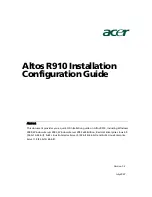
Issue 2.0
10-50
SV9100 NetLink
5.
When the communication servers come up, the Primary System and Secondary
Systems are connected and start working.
6.
For database synchronization, wait three minutes (or more).
S
ECTION
17 N
ET
L
INK
M
ULTI
-SIP C
ARRIER
When the Secondary NetLink system calls out using its own SIP Trunk, no
DSPs are used from the Primary system.
The NetLink Nodes which have their own SIP trunks can use Register IDs
independently of each other. A Secondary NetLink system is able to utilize its
own SIP trunks independently to the Primary system.
Conditions
When Programming SIP Trunks on a secondary system only SIP Profile
One can be utilized.
It is possible to set Register ID for trunks that belong to that specific
system. For example, a Register ID set in the Primary system cannot be
assigned to a trunk in the Secondary system. The allocation of the trunk
and Register ID of Program14-12 must be in the same system.
In order to use CPN in a Secondary system, Program 51-19 must be
turned on for those extensions. Once enabled, CPN may be sent on a
per station basis using Program 21-19.
Each NetLink system can use either SIP trunks to a provider or SIP
trunk TIE line mode, but not both.
Once NetLink is established, PCPro or WebPro must be used to change
the system data related to the SIP trunks.
Any SIP trunks that are built in a system before establishing NetLink will
be deleted after establishing NetLink.
SIP trunks are assigned in the order of system set up. System ID's are
needed to assign Program 10-40 data.
Registered SIP trunks can be utilized by any system in the NetLink
network, as long as trunk route programming allows it.
When a Secondary system becomes the primary after fail over, the SIP
trunks will work for the effective license time.
Summary of Contents for Univerge SV9100
Page 1: ...Networking Manual A50 035910 004 AU Issue 2 0...
Page 20: ...xviii Table of Contents Issue 2 0...
Page 26: ...xxiv List of Figures Issue 2 0...
Page 33: ...Book 1 SV9100 K CCIS...
Page 49: ...Issue 2 0 1 16 General Information US Only Figure 1 15 Circuit Identification Codes CIC...
Page 53: ...Issue 2 0 1 20 General Information US Only...
Page 61: ...Issue 2 0 2 8 Hardware Installation US Only...
Page 195: ...Issue 2 0 4 116 Features and Specifications...
Page 242: ...Book 2 SV9100 IP Networking...
Page 256: ...Issue 2 0 2 12 IP Networking...
Page 312: ...Issue 2 0 4 48 Programming...
Page 376: ...Issue 2 0 6 30 SIP Trunking...
Page 391: ...Issue 2 0 7 14 H 323 Trunking...
Page 467: ...Issue 2 0 8 76 IP Multiline Station SIP...
Page 551: ...Issue 2 0 10 64 SV9100 NetLink Conditions None Feature Cross Reference None...
Page 567: ...Issue 2 0 10 80 SV9100 NetLink Conditions None Feature Cross Reference None...
Page 579: ...Issue 2 0 11 6 NAPT...
Page 580: ...Issue 2 0 SV9100 Networking Manual 11 7...
Page 581: ...Issue 2 0 11 8 NAPT...
Page 582: ...Issue 2 0 SV9100 Networking Manual 11 9...
Page 583: ...Issue 2 0 11 10 NAPT...
Page 584: ...Issue 2 0 SV9100 Networking Manual 11 11...
Page 595: ...Issue 2 0 12 4 All DSP Busy Indication...
Page 671: ...Issue 2 0 13 76 AspireNet Conditions None Feature Cross Reference None...
Page 685: ...Issue 2 0 13 90 AspireNet Department Calling Flexible System Numbering Intercom...
Page 707: ...Issue 2 0 13 112 AspireNet Default Trunk Port Number Name 1 Line 001 2 Line 002 400 Line 400...
Page 713: ...Issue 2 0 13 118 AspireNet Department Calling...
Page 765: ...Issue 2 0 13 170 AspireNet...
















































